Unit 8 How do you make a banana milk shake? Section A (Grammar+Focus-3c) 课件(共57张PPT)
文档属性
| 名称 | Unit 8 How do you make a banana milk shake? Section A (Grammar+Focus-3c) 课件(共57张PPT) | 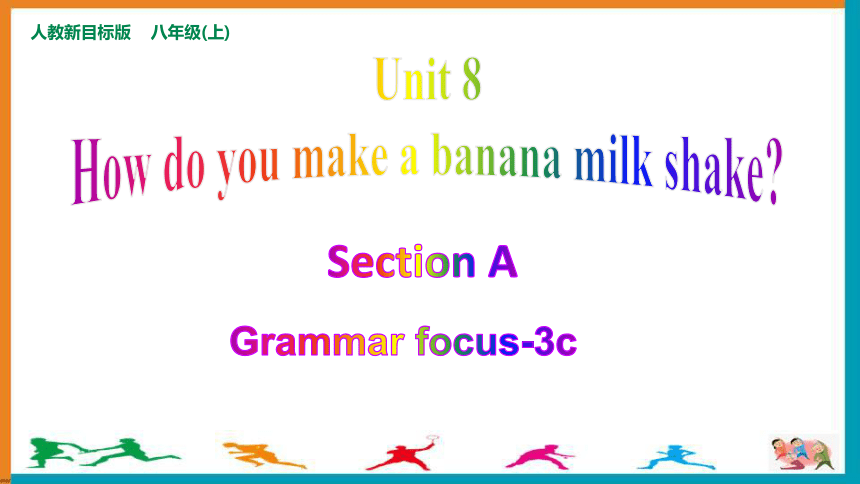 | |
| 格式 | pptx | ||
| 文件大小 | 5.5MB | ||
| 资源类型 | 教案 | ||
| 版本资源 | 人教新目标(Go for it)版 | ||
| 科目 | 英语 | ||
| 更新时间 | 2023-10-08 21:36:34 | ||
图片预览



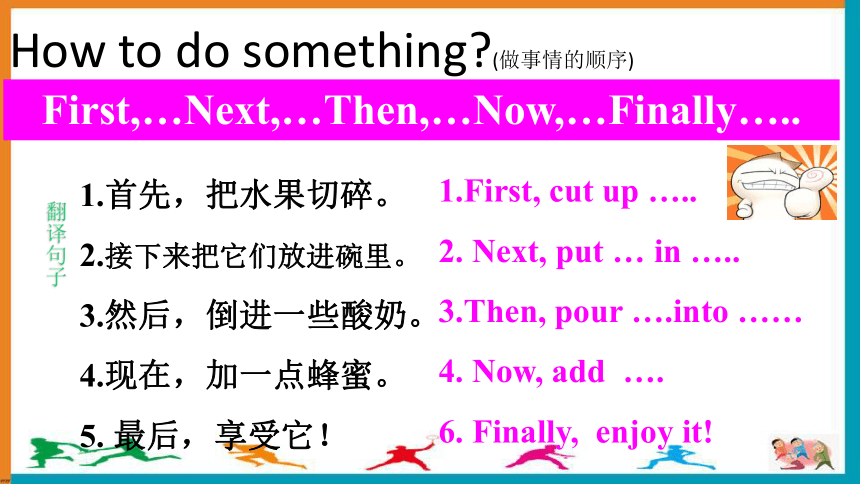
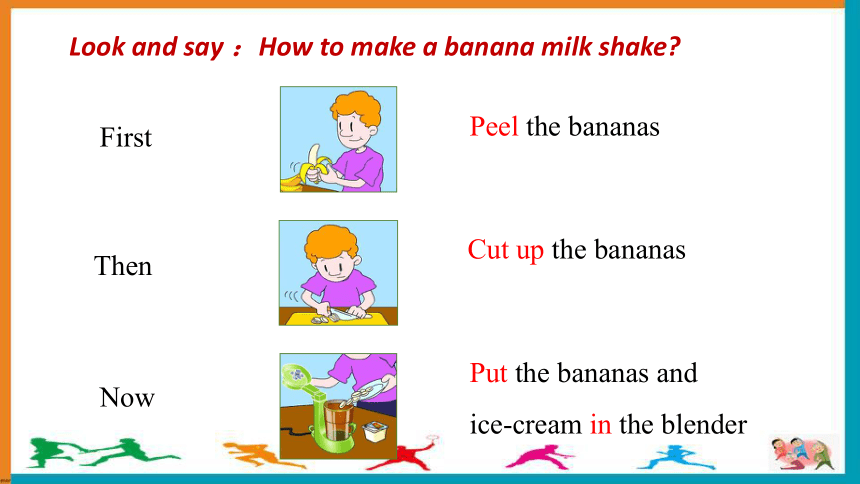
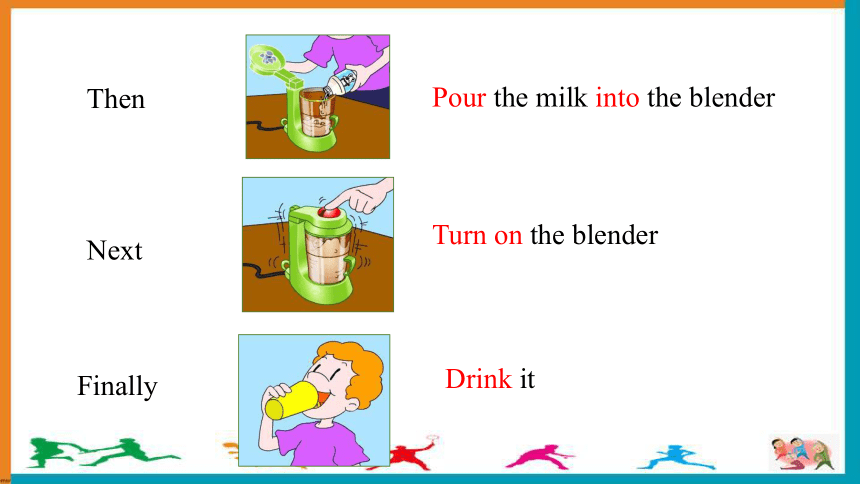
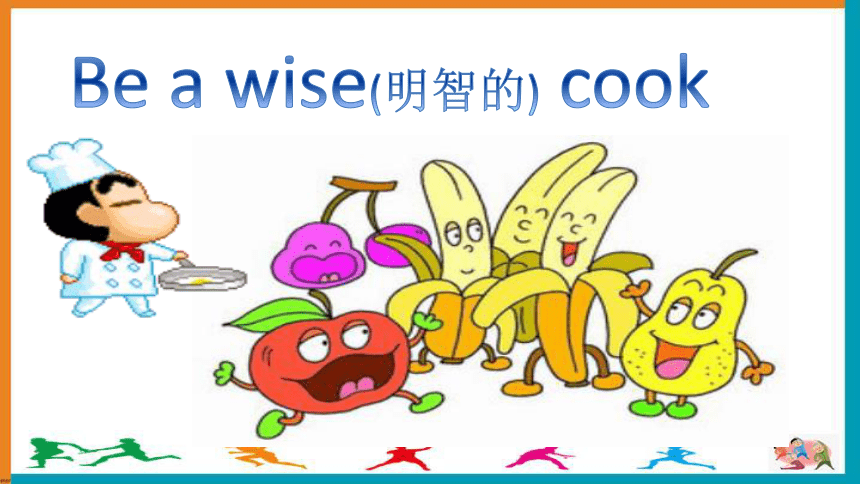

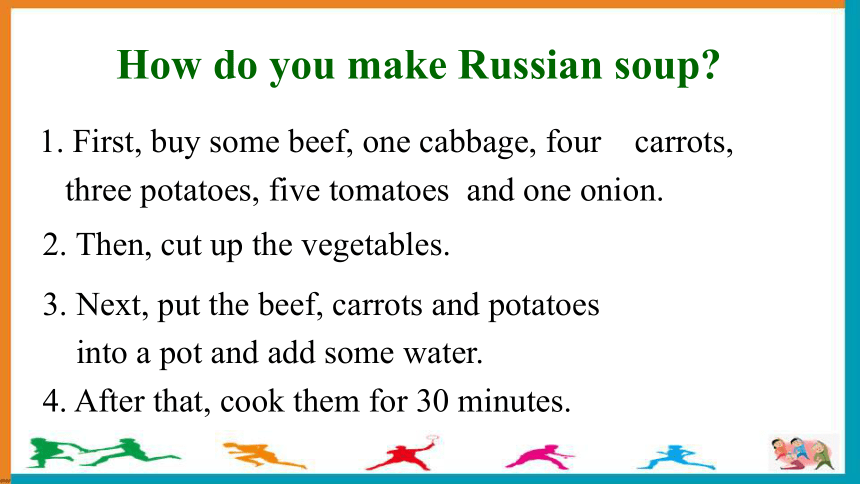

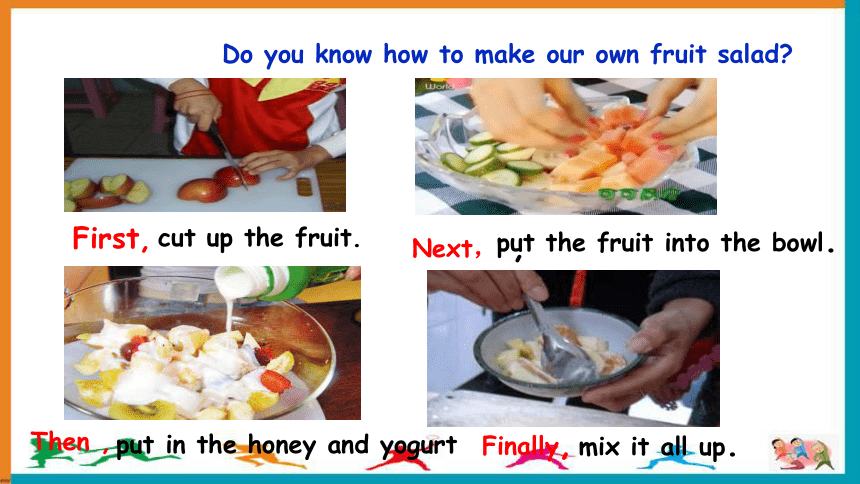
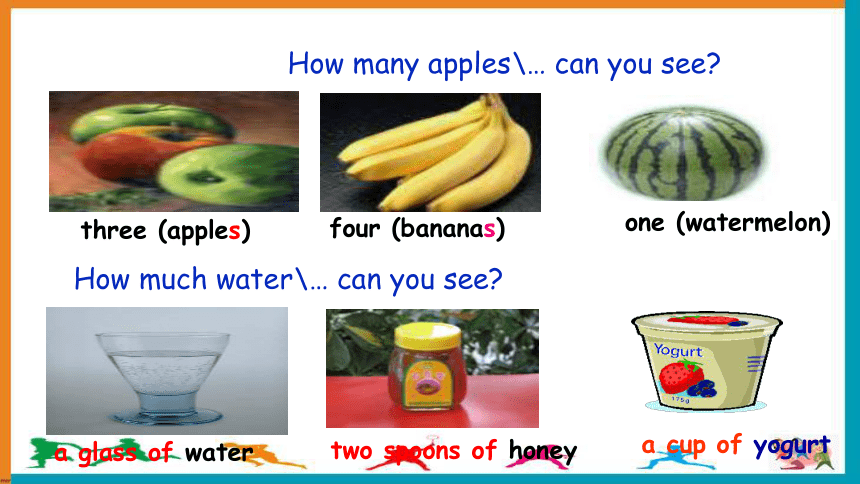
文档简介
(共57张PPT)
Section A
Grammar focus-3c
Unit 8
How do you make a banana milk shake
人教新目标版 八年级(上)
Learning Aims
文化意识:
培养学生的生活实践能力和动手能力。
03
思维品质:
通过简单食品制作,进一步培养逻辑思维。
04
学习能力:
掌握祈使句的使用;正确区分可数名词和不可数名词。
02
语言知识:
准确运用how much和how many对事物的数量进行提问。
01
Let's cook delicious food!
Revison:
fruit salad
milk shake
Russian soup
First,…Next,…Then,…Now,…Finally…..
How to do something (做事情的顺序)
1.首先,把水果切碎。
2.接下来把它们放进碗里。
3.然后,倒进一些酸奶。
4.现在,加一点蜂蜜。
5. 最后,享受它!
1.First, cut up …..
2. Next, put … in …..
3.Then, pour ….into ……
4. Now, add ….
6. Finally, enjoy it!
翻译句子
First
Peel the bananas
Cut up the bananas
Then
Put the bananas and
ice-cream in the blender
Now
Look and say :How to make a banana milk shake
Pour the milk into the blender
Then
Turn on the blender
Drink it
Next
Finally
Be a wise(明智的) cook
How much
How many
oranges
tomatoes
salt
watermelons
milk
spoons
yogurt
strawberries
honey
tea
apples
bananas
2. Then, cut up the vegetables.
1. First, buy some beef, one cabbage, four carrots, three potatoes, five tomatoes and one onion.
How do you make Russian soup
3. Next, put the beef, carrots and potatoes
into a pot and add some water.
4. After that, cook them for 30 minutes.
6. And don’t forget to add some salt.
5. Then, add the cabbage, tomatoes and
onion and cook for another 10 minutes.
mix it all up.
cut up the fruit.
put the fruit into the bowl.
First,
Next, ,
Then ,
put in the honey and yogurt
Finally,
Do you know how to make our own fruit salad
three (apples)
How many apples\… can you see
four (bananas)
a glass of water
one (watermelon)
How much water\… can you see
two spoons of honey
a cup of yogurt
What do we need for your favorite fruit salad
How many or how much of them do we need
How do we ask about quantities of countable nouns
— How many apples/tomatoes/ strawberries do we need
— Three/ Four/ One and a half.
How do we ask about quantities of uncountable nouns
— How much milk/yogurt/honey do we need
— One glass/ Two spoons/ Fifteen grams.
yogurt
honey
milk
根据课本内容,完成下列句子。
1. 你怎样做香蕉奶昔?
_____ do you _____ a banana milk shake
2. 首先,将香蕉剥皮。
______, _____ the bananas.
3. 接下来,将香蕉放入果汁机中。
____, _____ the bananas in the blender.
4. 然后,将牛奶倒进果汁机中。
_____, _____ the milk ____ the blender.
First peel
How make
Next put
Then pour into
Grammar focus
5. 最后,打开果汁机。
______, _______ ___ the blender.
6. 我们需要多少香蕉?
______ _____ bananas do we need
7. 我们需要三只香蕉。
We ______ three _________.
8. 我们需要多少酸奶?
_____ _____ yogurt do we need
9. 我们需要一杯酸奶。
We need ___ ____ ____ yogurt.
Finally turn on
How many
need bananas
How much
one cup of
情况 构成方法 读音
一般情况
1. 可数名词单数变复数的规则
(1) 规则变化
可数名词复数的构成,通常是在单数形式后面加s或es,其方法如下:
加-s
在清辅音后读/s/
在浊辅音和元音后读/z/
情况 构成方法 读音
以s, x, ch, sh等 结尾的大多数词
加-es
读/ z/
以辅音字母加y结尾的词
变y为i,再加-es
读/ z/
以f (e) 结尾的词
变f (e) 为v,
再加-es
读/vz/
以字母o结尾的名词有的加-es,有的加-s。
potato → potatoes 土豆
tomato → tomatoes 西红杮
radio → radios 收音机
photo → photos 照片
es和s都读/z/
(1) 元音或词尾发生变化:
如:child--_________, mouse-- _________,
man--________, woman--_________,
foot--_________, tooth--_________, goose--_________
policeman--___________, Frenchman--_________
Englishman--_________
口诀:男士(man)、女士(woman)a变e;鹅(goose)牙(tooth)脚(foot)双o双e;孩子们(child)想去天安门,原形后面r、e、n)
children
mice
men
women
feet
teeth
geese
policemen
Frenchmen
Englishmen
可数名词复数的变化规则不规则变化:
(2) 单复数同形:
如:deer---deer fish----fish sheep----sheep Chinese ----Chinese Japanese---Japanese yuan---yuan
口诀:中(Chinese)日(Japanese)警察(police)好友(people)来聚会,鹿(deep)、羊(sheep)、鱼(fish)、牛(cattle)齐齐把家回
注意:(1) glasses, shoes, socks, trousers, gloves等名词往往用复数形式,故谓语用复数。如:The trousers are very cheap and I want to take them.
(2) maths, news等虽然有s结尾,但不是复数,因此谓语仍用单数,如:The news is very exciting.
(3) “某国人”的复数形式 “中日不变英法变,其余s加后边”
国家名 国籍 单数 复数
China 中国人 a Chinese two Chinese
Japan 日本人 a Japanese two Japanese
England 英国人 an Englishman two Englishmen
France 法国人 a Frenchman two Frenchmen
Australia 澳大利亚人 an Australian two Australians
Russia 俄国人 a Russian two Russians
Italy 意大利人 an Italian two Italians
America 美国人 an American two Americans
India 印度人 an Indian two Indians
Canada 加拿大人 a Canadian two Canadians
Germany 德国人 a German two Germans
可数名词复数的变化规则
通常情况下,当一个名词作定语修饰另一个名词时,变复数时只把后一个名词变为复数。 但当man 或woman修饰另一个名词时, 变复数时要把man或woman和另一个名词一起变为复数。
an apple tree---apple trees 苹果树
a woman leader ----women leaders 女领导
a man doctor---men doctors 男医生
不可数名词
物质名词一般是不可数名词,它们所表示的事物不能用数来计数。如:rice, milk, yogurt, beef, …
1.不可数名词可以用much, a little , a bit of , some, any, a lot of/lots of等表示多少
如:some tea一些茶,a little bread一点儿面包,
much meat许多肉,a lot of water大量的水
2.不可数名词的具体数量可以用适当的量词(由普通名词充当)作单位来表示,结构为“数词 + 量词(普通名词)+ of + 不可数名词”。
常用的词有cup(杯),glass(玻璃杯),bottle(瓶),piece(片),bag(袋)等。
其单复数变化就体现在量词上。
a bottle of orange一瓶橙汁,
two pieces of meat 两块肉
three bags of rice三袋米
询问可数名词的“多少”用how many
How much + 不可数名词
询问不可数名词的“多少”用 how much
How many + 可数名词复数
1. How ( much /many) bananas do we need
2. How (much / many) sugar do we need
3. How ( much / many) bread do we need
4. How ( much / many) tomatoes do we need
5. How ( much /many) cheese do we need
可数名词有单数和复数两种形式,如:bananas, tomatoes
可数名词单数前必须要有限定词:
an apple a friend my book Tom's pen
I like your girlfriend.
I like apple.
Tom gave his friend a basketball.
Tom gave friend basketball.
不可数名词没有单、复数之分, 如:water, bread, paper
不可数名词前不能有a (an),one,two,three等数词
a information two paper
英语中量的表达方法分为两种类型:
1.只适用于可数名词:数词+可数名词
a dog 100 lives many men
2. 适用于所有名词:... of ...
① 数词+计量单位+ of...
a cup of tea two bowls of rice
a group of persons two sets of keys
100 bowls of vegetables
② 其他词 + of
most of the time some of his friends
many spoons of honey
快速抢答
用 how many or how much填空.
How much
How many
How much
How many
How much
2 _________bananas do we need
3 __________cheese do we need
4 _________tomatoes do we need
5 __________bread do we need
1 ___________sugar do we need
祈使句可以表达叮嘱、劝告、禁止、请求、建议或命令等。
1. 以动词原形开头, 没有时态和数的变化;
2. 否定形式是在动词原形前加don’t;
3. 暗含的主语是you, 但通常省略。
动词原形构成的祈使句
e.g.
Drink the milk…
Cup up the watermelon…
Pour some water…
Put some water in/into…
Peel the apple…
Cook the meat for …
Don’t bring food to the museum.
Do型
Be型
肯定形式:实义动词原形 (+其他).
否定形式:Don’t +实义动词原形 (+其他).
肯定形式:Be +表语 (+其他).
否定形式:Don’t +be +表语 (+其他).
Let型
No型
肯定形式:Let+宾语+v.原形 (+其他).
否定形式:Don’t +let+宾语+v.原形 (+其他).
/ Let+宾语+not+v.原形 (+其他).
No+名词/动词-ing形式.
2. 祈使句的回答
回答祈使句时一般用will或won’t。回答肯定形式的祈使句用will,回答否定形式的祈使句用won’t。
例句:—首先,清洗这些蔬菜。
—First, wash these vegetables.
—好的,我会的。—OK, I will.
注意:
(1)为了表示委婉的语气可在句首或句尾加上please,但please加在句尾时,前面要用逗号隔开。
eg:Please sit down. 请坐。
Stand up,please. 请起立。
(2)在意思较为明显的情况下,可把谓语动词省去。
eg:This way,please.请这边走。
(3)“No + 名词或动名词”也是祈使句的一种,表示“禁止”,含否定含义,经常用于公共场合。
No photos.禁止拍照。 No smoking.禁止吸烟。
(4)某些名词、形容词或副词等后面加感叹号,也可作为祈使句。
Hands up! 举起手! Taxi! 出租车!
3. 祈使句的反意疑问句
(1) 肯定形式的祈使句,表示请求时,附加问句
通常用will you或 would you;表示劝说、邀
请时,附加问句通常用won’t you。
例句:下次仔细点,好吗
Be more careful next time, will you
(2) 否定形式的祈使句,附加问句只能用will you。
例句:不要玩电脑游戏,好吗
Don’t play computer games, will you
(3) 以let’s开头的祈使句,附加问句要用shall we;
以 let us开头的祈使句,附加问句要用will you。
例句:现在我们看卡通片吧,好吗
Let’s watch the cartoon now, shall we
让我们回家,好吗
Let us go home, will you
1. How ( much /many) bananas do we need
2. How (much / many) sugar do we need
3. How ( much / many) bread do we need
4. How ( much / many) tomatoes do we need
5. How ( much /many) cheese do we need
Circle the correct word in each question.
3a
First, put the corn
into the machine.
Next turn on the machine.
Next pour the
popcorn into the bowl.
Then put salt on
the popcorn.
Finally eat the popcorn.
Complete the questions and answers. Then match them.
3b
Complete the questions and answer. Then match them.
3b
___ 1. ___________ do you make popcorn
___ 2. ___________ corn do we need
___ 3. ___________ do we do next
___ 4. ___________ salt do we need
___ 5. Now can we eat it
a. Half a cup.
b. ___, put the corn into the popcorn machine.
c. Yes, we can!
d. Next, ___ on the machine. _____, add the salt.
e. Just one spoon.
How
How much
What
How much
First
turn
Finally
b
a
d
e
c
Write how to do one of the following things. Then tell your partner how to do it.
plant a tree
make beef noodles
wash clothes
get a book from the library
3c
我都 学会了!
本课句型
Summary
1、用祈使句表达说话者的要求:
2、用 “first, next, then…等来表达顺序:
Peel the bananas.
Pour the milk in the blender.
First, cut up the bananas; Then…; Next…; Finally…
3、用 How many/much…来询问数量
动词原形构成的祈使句
祈使句可以表达叮嘱、劝告、禁止、请求、建议或命令等。
以动词原形开头, 没有时态和数的变化;暗含的主语是you, 但通常省略。
1. 肯定的祈使句 (1) 动词原形+其他 e.g. Stand up, please.=Please stand up. 请起立。
(2) Be+adj. e.g. Be careful!=Look out!=Take care! 小心 / 当心!
(3) Let’s+动词原形 e.g. Let’s go to school together. 咱们一起上学去吧。
2. 否定的祈使句 (1) Don’t + 动词原形 e.g. Don’t stand up. 别站起来。
Don’t be careless. 别粗心。Don’t let them play with fire. 别让他们玩火。
(2) Let’s (let sb.)+not+动词原形 e.g. Let’s not say anything about it. 对于这件事,咱们什么也别说。
Let them not play with fire. 别让他们玩火。 (3) No +n./V.-ing e.g. No photos!/ No smoking!
Grammar Focus
Grammar Focus
表示顺序的副词,可用来表达制作步骤的先后顺序。
有时候吩咐别人做的某件事要分步骤来完成,并且有一个先后顺序,这时候可以适当地使用 first, next, then 和finally,既能使说话人喘口气,又能使听话者感到句子的连贯性。
First...(首先……), next...(接下来……),then...(然后……), finally...(最后……).
______,peel…
______,cut
up…
______,put…in…
______,put…into…
______, turn on…
______,drink…
First
And
Next
Next
Then
Finally
Grammar Focus
可数名词与不可数名词
名词按其所表示的事物的性质分为可数名词和不可数名词。可数名词有单数和负数的变化,不可数名词没有。
可数名词:如banana, apple, onion, pear, desk, … 不可数名词: 如milk, yogurt, honey, work, news, rice…
可数名词前可以加a\an表示一个,也可用基数词或者many等直接修饰可数名词,如a banana, an apple, three pears
等;但是不可数名词前不能加a\an表示一个,也不能用基数词或者many等直接修饰不可数名词,要表达不可数
名词的量要用“基数词+单位词+of ”。如:one cup / bottle of water ,three spoons of soup,one bowl of rice
one box of milk, two kilos of yogurt
如何问答名词的数量?
1. 询问可数名词的数量:__________ + 可数名词……
2. 询问不可数名词的数量: _________ + 不可数名词 ……
回答不可数名词的数量:___________ + 不可数名词 一杯 ____________; 一碗 __________
How many
How much
数量词
a cup of
a bowl of
This boy has three pens. (对划线部分提问)
→How many pens does this boy have
I ate two bowls of rice. (对划线部分提问)
→How much rice did you eat
一、用括号中所给单词的适当形式填空。
1. (come) in,please.
2. (not play) with fire.
3.How much (water) is there in the cup
4.Let him (play) football.
5.How many (apple) do you need
Come
water
play
apples
Exercises
二、单项选择
1. It’s getting dark. Can you ______ the light
A. turn off B. turn on C. turn over
2. — ________ yogurt do you need
— One teaspoon.
A. How many B. How much C. Which
B
B
3. The baby can eat ____ bread for breakfast.
A. two B. many of C. two slices of
4. I have _______ bananas in the fridge.
A. a lot B. many C. much
5. Would you like ____ relish on the bread
A. many B. any C. some
C
B
C
C
B
( )6.You can _____ some sugar _______ the water.
A.add;/ B.add;with
C.add;to D.add up;to
( )7.________ honey do you need
A.How many B.How much
C.How often D.How long
1. You shouldn’t stay up late tonight. (改为祈使句)
________ ________ ________ late tonight.
2. I can help you with your English. (改为祈使句)
________ ________ help you with your English.
3. We need to buy two bags of salt. (对画线部分提问)
________ ________ ________ do you need to buy
Don’t
stay
up
Let
me
How
much
salt
三、按要求完成句子,每空一词。
4. Dave bought three kilos of rice for us yesterday.
(对画线部分提问)
________ ________ ________ of rice did Dave
buy for you yesterday
5. There is a tomato in the box.
(用three代替a改写句子)
There ________ three ________ in the box.
How
many
kilos
are
tomatoes
1. 请把书放进你的书包里。
Please ______ your books ______ your backpack.
2. 把盐加到面条里。
______ salt ______ the noodles.
四、根据汉语意思完成句子
put
in/ into
Add
to
3. 她往瓶子里倒进了一些热水。
She ______ some hot water ______ the glass.
4. 请告诉我怎样找到我的书。
Please tell me ______ ______ ______ my book.
5. 他喝了两杯茶。
He drank two ______ ______ tea.
pours
into
how to find
cups of
Homework
1. 复习Grammar Focus中的内容。
2. 从3c中选择一个活动项目,用英语将其过程描写出来。注意正确运用表示顺序的词汇:fist, next, then, after that, finally。
Thank you !
人教新目标版 八年级(上)
Section A
Grammar focus-3c
Unit 8
How do you make a banana milk shake
人教新目标版 八年级(上)
Learning Aims
文化意识:
培养学生的生活实践能力和动手能力。
03
思维品质:
通过简单食品制作,进一步培养逻辑思维。
04
学习能力:
掌握祈使句的使用;正确区分可数名词和不可数名词。
02
语言知识:
准确运用how much和how many对事物的数量进行提问。
01
Let's cook delicious food!
Revison:
fruit salad
milk shake
Russian soup
First,…Next,…Then,…Now,…Finally…..
How to do something (做事情的顺序)
1.首先,把水果切碎。
2.接下来把它们放进碗里。
3.然后,倒进一些酸奶。
4.现在,加一点蜂蜜。
5. 最后,享受它!
1.First, cut up …..
2. Next, put … in …..
3.Then, pour ….into ……
4. Now, add ….
6. Finally, enjoy it!
翻译句子
First
Peel the bananas
Cut up the bananas
Then
Put the bananas and
ice-cream in the blender
Now
Look and say :How to make a banana milk shake
Pour the milk into the blender
Then
Turn on the blender
Drink it
Next
Finally
Be a wise(明智的) cook
How much
How many
oranges
tomatoes
salt
watermelons
milk
spoons
yogurt
strawberries
honey
tea
apples
bananas
2. Then, cut up the vegetables.
1. First, buy some beef, one cabbage, four carrots, three potatoes, five tomatoes and one onion.
How do you make Russian soup
3. Next, put the beef, carrots and potatoes
into a pot and add some water.
4. After that, cook them for 30 minutes.
6. And don’t forget to add some salt.
5. Then, add the cabbage, tomatoes and
onion and cook for another 10 minutes.
mix it all up.
cut up the fruit.
put the fruit into the bowl.
First,
Next, ,
Then ,
put in the honey and yogurt
Finally,
Do you know how to make our own fruit salad
three (apples)
How many apples\… can you see
four (bananas)
a glass of water
one (watermelon)
How much water\… can you see
two spoons of honey
a cup of yogurt
What do we need for your favorite fruit salad
How many or how much of them do we need
How do we ask about quantities of countable nouns
— How many apples/tomatoes/ strawberries do we need
— Three/ Four/ One and a half.
How do we ask about quantities of uncountable nouns
— How much milk/yogurt/honey do we need
— One glass/ Two spoons/ Fifteen grams.
yogurt
honey
milk
根据课本内容,完成下列句子。
1. 你怎样做香蕉奶昔?
_____ do you _____ a banana milk shake
2. 首先,将香蕉剥皮。
______, _____ the bananas.
3. 接下来,将香蕉放入果汁机中。
____, _____ the bananas in the blender.
4. 然后,将牛奶倒进果汁机中。
_____, _____ the milk ____ the blender.
First peel
How make
Next put
Then pour into
Grammar focus
5. 最后,打开果汁机。
______, _______ ___ the blender.
6. 我们需要多少香蕉?
______ _____ bananas do we need
7. 我们需要三只香蕉。
We ______ three _________.
8. 我们需要多少酸奶?
_____ _____ yogurt do we need
9. 我们需要一杯酸奶。
We need ___ ____ ____ yogurt.
Finally turn on
How many
need bananas
How much
one cup of
情况 构成方法 读音
一般情况
1. 可数名词单数变复数的规则
(1) 规则变化
可数名词复数的构成,通常是在单数形式后面加s或es,其方法如下:
加-s
在清辅音后读/s/
在浊辅音和元音后读/z/
情况 构成方法 读音
以s, x, ch, sh等 结尾的大多数词
加-es
读/ z/
以辅音字母加y结尾的词
变y为i,再加-es
读/ z/
以f (e) 结尾的词
变f (e) 为v,
再加-es
读/vz/
以字母o结尾的名词有的加-es,有的加-s。
potato → potatoes 土豆
tomato → tomatoes 西红杮
radio → radios 收音机
photo → photos 照片
es和s都读/z/
(1) 元音或词尾发生变化:
如:child--_________, mouse-- _________,
man--________, woman--_________,
foot--_________, tooth--_________, goose--_________
policeman--___________, Frenchman--_________
Englishman--_________
口诀:男士(man)、女士(woman)a变e;鹅(goose)牙(tooth)脚(foot)双o双e;孩子们(child)想去天安门,原形后面r、e、n)
children
mice
men
women
feet
teeth
geese
policemen
Frenchmen
Englishmen
可数名词复数的变化规则不规则变化:
(2) 单复数同形:
如:deer---deer fish----fish sheep----sheep Chinese ----Chinese Japanese---Japanese yuan---yuan
口诀:中(Chinese)日(Japanese)警察(police)好友(people)来聚会,鹿(deep)、羊(sheep)、鱼(fish)、牛(cattle)齐齐把家回
注意:(1) glasses, shoes, socks, trousers, gloves等名词往往用复数形式,故谓语用复数。如:The trousers are very cheap and I want to take them.
(2) maths, news等虽然有s结尾,但不是复数,因此谓语仍用单数,如:The news is very exciting.
(3) “某国人”的复数形式 “中日不变英法变,其余s加后边”
国家名 国籍 单数 复数
China 中国人 a Chinese two Chinese
Japan 日本人 a Japanese two Japanese
England 英国人 an Englishman two Englishmen
France 法国人 a Frenchman two Frenchmen
Australia 澳大利亚人 an Australian two Australians
Russia 俄国人 a Russian two Russians
Italy 意大利人 an Italian two Italians
America 美国人 an American two Americans
India 印度人 an Indian two Indians
Canada 加拿大人 a Canadian two Canadians
Germany 德国人 a German two Germans
可数名词复数的变化规则
通常情况下,当一个名词作定语修饰另一个名词时,变复数时只把后一个名词变为复数。 但当man 或woman修饰另一个名词时, 变复数时要把man或woman和另一个名词一起变为复数。
an apple tree---apple trees 苹果树
a woman leader ----women leaders 女领导
a man doctor---men doctors 男医生
不可数名词
物质名词一般是不可数名词,它们所表示的事物不能用数来计数。如:rice, milk, yogurt, beef, …
1.不可数名词可以用much, a little , a bit of , some, any, a lot of/lots of等表示多少
如:some tea一些茶,a little bread一点儿面包,
much meat许多肉,a lot of water大量的水
2.不可数名词的具体数量可以用适当的量词(由普通名词充当)作单位来表示,结构为“数词 + 量词(普通名词)+ of + 不可数名词”。
常用的词有cup(杯),glass(玻璃杯),bottle(瓶),piece(片),bag(袋)等。
其单复数变化就体现在量词上。
a bottle of orange一瓶橙汁,
two pieces of meat 两块肉
three bags of rice三袋米
询问可数名词的“多少”用how many
How much + 不可数名词
询问不可数名词的“多少”用 how much
How many + 可数名词复数
1. How ( much /many) bananas do we need
2. How (much / many) sugar do we need
3. How ( much / many) bread do we need
4. How ( much / many) tomatoes do we need
5. How ( much /many) cheese do we need
可数名词有单数和复数两种形式,如:bananas, tomatoes
可数名词单数前必须要有限定词:
an apple a friend my book Tom's pen
I like your girlfriend.
I like apple.
Tom gave his friend a basketball.
Tom gave friend basketball.
不可数名词没有单、复数之分, 如:water, bread, paper
不可数名词前不能有a (an),one,two,three等数词
a information two paper
英语中量的表达方法分为两种类型:
1.只适用于可数名词:数词+可数名词
a dog 100 lives many men
2. 适用于所有名词:... of ...
① 数词+计量单位+ of...
a cup of tea two bowls of rice
a group of persons two sets of keys
100 bowls of vegetables
② 其他词 + of
most of the time some of his friends
many spoons of honey
快速抢答
用 how many or how much填空.
How much
How many
How much
How many
How much
2 _________bananas do we need
3 __________cheese do we need
4 _________tomatoes do we need
5 __________bread do we need
1 ___________sugar do we need
祈使句可以表达叮嘱、劝告、禁止、请求、建议或命令等。
1. 以动词原形开头, 没有时态和数的变化;
2. 否定形式是在动词原形前加don’t;
3. 暗含的主语是you, 但通常省略。
动词原形构成的祈使句
e.g.
Drink the milk…
Cup up the watermelon…
Pour some water…
Put some water in/into…
Peel the apple…
Cook the meat for …
Don’t bring food to the museum.
Do型
Be型
肯定形式:实义动词原形 (+其他).
否定形式:Don’t +实义动词原形 (+其他).
肯定形式:Be +表语 (+其他).
否定形式:Don’t +be +表语 (+其他).
Let型
No型
肯定形式:Let+宾语+v.原形 (+其他).
否定形式:Don’t +let+宾语+v.原形 (+其他).
/ Let+宾语+not+v.原形 (+其他).
No+名词/动词-ing形式.
2. 祈使句的回答
回答祈使句时一般用will或won’t。回答肯定形式的祈使句用will,回答否定形式的祈使句用won’t。
例句:—首先,清洗这些蔬菜。
—First, wash these vegetables.
—好的,我会的。—OK, I will.
注意:
(1)为了表示委婉的语气可在句首或句尾加上please,但please加在句尾时,前面要用逗号隔开。
eg:Please sit down. 请坐。
Stand up,please. 请起立。
(2)在意思较为明显的情况下,可把谓语动词省去。
eg:This way,please.请这边走。
(3)“No + 名词或动名词”也是祈使句的一种,表示“禁止”,含否定含义,经常用于公共场合。
No photos.禁止拍照。 No smoking.禁止吸烟。
(4)某些名词、形容词或副词等后面加感叹号,也可作为祈使句。
Hands up! 举起手! Taxi! 出租车!
3. 祈使句的反意疑问句
(1) 肯定形式的祈使句,表示请求时,附加问句
通常用will you或 would you;表示劝说、邀
请时,附加问句通常用won’t you。
例句:下次仔细点,好吗
Be more careful next time, will you
(2) 否定形式的祈使句,附加问句只能用will you。
例句:不要玩电脑游戏,好吗
Don’t play computer games, will you
(3) 以let’s开头的祈使句,附加问句要用shall we;
以 let us开头的祈使句,附加问句要用will you。
例句:现在我们看卡通片吧,好吗
Let’s watch the cartoon now, shall we
让我们回家,好吗
Let us go home, will you
1. How ( much /many) bananas do we need
2. How (much / many) sugar do we need
3. How ( much / many) bread do we need
4. How ( much / many) tomatoes do we need
5. How ( much /many) cheese do we need
Circle the correct word in each question.
3a
First, put the corn
into the machine.
Next turn on the machine.
Next pour the
popcorn into the bowl.
Then put salt on
the popcorn.
Finally eat the popcorn.
Complete the questions and answers. Then match them.
3b
Complete the questions and answer. Then match them.
3b
___ 1. ___________ do you make popcorn
___ 2. ___________ corn do we need
___ 3. ___________ do we do next
___ 4. ___________ salt do we need
___ 5. Now can we eat it
a. Half a cup.
b. ___, put the corn into the popcorn machine.
c. Yes, we can!
d. Next, ___ on the machine. _____, add the salt.
e. Just one spoon.
How
How much
What
How much
First
turn
Finally
b
a
d
e
c
Write how to do one of the following things. Then tell your partner how to do it.
plant a tree
make beef noodles
wash clothes
get a book from the library
3c
我都 学会了!
本课句型
Summary
1、用祈使句表达说话者的要求:
2、用 “first, next, then…等来表达顺序:
Peel the bananas.
Pour the milk in the blender.
First, cut up the bananas; Then…; Next…; Finally…
3、用 How many/much…来询问数量
动词原形构成的祈使句
祈使句可以表达叮嘱、劝告、禁止、请求、建议或命令等。
以动词原形开头, 没有时态和数的变化;暗含的主语是you, 但通常省略。
1. 肯定的祈使句 (1) 动词原形+其他 e.g. Stand up, please.=Please stand up. 请起立。
(2) Be+adj. e.g. Be careful!=Look out!=Take care! 小心 / 当心!
(3) Let’s+动词原形 e.g. Let’s go to school together. 咱们一起上学去吧。
2. 否定的祈使句 (1) Don’t + 动词原形 e.g. Don’t stand up. 别站起来。
Don’t be careless. 别粗心。Don’t let them play with fire. 别让他们玩火。
(2) Let’s (let sb.)+not+动词原形 e.g. Let’s not say anything about it. 对于这件事,咱们什么也别说。
Let them not play with fire. 别让他们玩火。 (3) No +n./V.-ing e.g. No photos!/ No smoking!
Grammar Focus
Grammar Focus
表示顺序的副词,可用来表达制作步骤的先后顺序。
有时候吩咐别人做的某件事要分步骤来完成,并且有一个先后顺序,这时候可以适当地使用 first, next, then 和finally,既能使说话人喘口气,又能使听话者感到句子的连贯性。
First...(首先……), next...(接下来……),then...(然后……), finally...(最后……).
______,peel…
______,cut
up…
______,put…in…
______,put…into…
______, turn on…
______,drink…
First
And
Next
Next
Then
Finally
Grammar Focus
可数名词与不可数名词
名词按其所表示的事物的性质分为可数名词和不可数名词。可数名词有单数和负数的变化,不可数名词没有。
可数名词:如banana, apple, onion, pear, desk, … 不可数名词: 如milk, yogurt, honey, work, news, rice…
可数名词前可以加a\an表示一个,也可用基数词或者many等直接修饰可数名词,如a banana, an apple, three pears
等;但是不可数名词前不能加a\an表示一个,也不能用基数词或者many等直接修饰不可数名词,要表达不可数
名词的量要用“基数词+单位词+of ”。如:one cup / bottle of water ,three spoons of soup,one bowl of rice
one box of milk, two kilos of yogurt
如何问答名词的数量?
1. 询问可数名词的数量:__________ + 可数名词……
2. 询问不可数名词的数量: _________ + 不可数名词 ……
回答不可数名词的数量:___________ + 不可数名词 一杯 ____________; 一碗 __________
How many
How much
数量词
a cup of
a bowl of
This boy has three pens. (对划线部分提问)
→How many pens does this boy have
I ate two bowls of rice. (对划线部分提问)
→How much rice did you eat
一、用括号中所给单词的适当形式填空。
1. (come) in,please.
2. (not play) with fire.
3.How much (water) is there in the cup
4.Let him (play) football.
5.How many (apple) do you need
Come
water
play
apples
Exercises
二、单项选择
1. It’s getting dark. Can you ______ the light
A. turn off B. turn on C. turn over
2. — ________ yogurt do you need
— One teaspoon.
A. How many B. How much C. Which
B
B
3. The baby can eat ____ bread for breakfast.
A. two B. many of C. two slices of
4. I have _______ bananas in the fridge.
A. a lot B. many C. much
5. Would you like ____ relish on the bread
A. many B. any C. some
C
B
C
C
B
( )6.You can _____ some sugar _______ the water.
A.add;/ B.add;with
C.add;to D.add up;to
( )7.________ honey do you need
A.How many B.How much
C.How often D.How long
1. You shouldn’t stay up late tonight. (改为祈使句)
________ ________ ________ late tonight.
2. I can help you with your English. (改为祈使句)
________ ________ help you with your English.
3. We need to buy two bags of salt. (对画线部分提问)
________ ________ ________ do you need to buy
Don’t
stay
up
Let
me
How
much
salt
三、按要求完成句子,每空一词。
4. Dave bought three kilos of rice for us yesterday.
(对画线部分提问)
________ ________ ________ of rice did Dave
buy for you yesterday
5. There is a tomato in the box.
(用three代替a改写句子)
There ________ three ________ in the box.
How
many
kilos
are
tomatoes
1. 请把书放进你的书包里。
Please ______ your books ______ your backpack.
2. 把盐加到面条里。
______ salt ______ the noodles.
四、根据汉语意思完成句子
put
in/ into
Add
to
3. 她往瓶子里倒进了一些热水。
She ______ some hot water ______ the glass.
4. 请告诉我怎样找到我的书。
Please tell me ______ ______ ______ my book.
5. 他喝了两杯茶。
He drank two ______ ______ tea.
pours
into
how to find
cups of
Homework
1. 复习Grammar Focus中的内容。
2. 从3c中选择一个活动项目,用英语将其过程描写出来。注意正确运用表示顺序的词汇:fist, next, then, after that, finally。
Thank you !
人教新目标版 八年级(上)
同课章节目录
- Unit 1 Where did you go on vacation?
- Section A
- Section B
- Unit 2 How often do you exercise?
- Section A
- Section B
- Unit 3 I'm more outgoing than my sister.
- Section A
- Section B
- Unit 4 What's the best movie theater?
- Section A
- Section B
- Unit 5 Do you want to watch a game show?
- Section A
- Section B
- Unit 6 I'm going to study computer science.
- Section A
- Section B
- Unit 7 Will people have robots?
- Section A
- Section B
- Unit 8 How do you make a banana milk shake?
- Section A
- Section B
- Unit 9 Can you come to my party?
- Section A
- Section B
- Unit 10 If you go to the party, you'll have a grea
- Section A
- Section B
